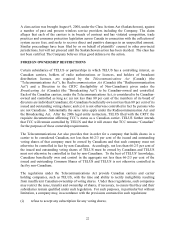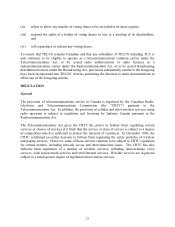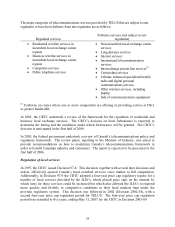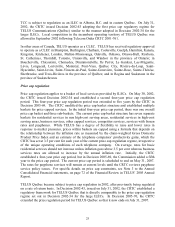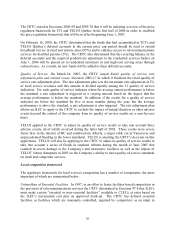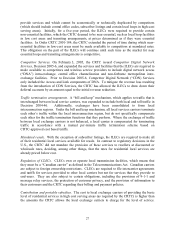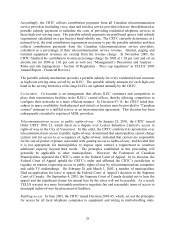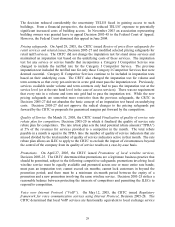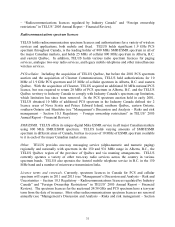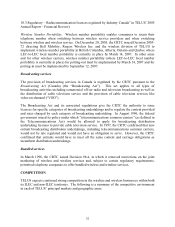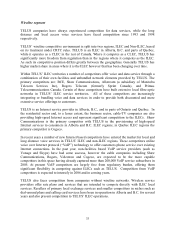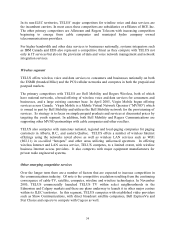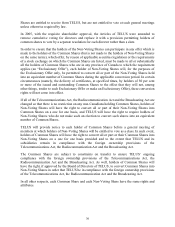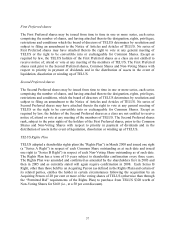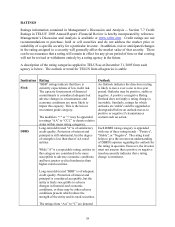Telus 2005 Annual Report Download - page 30
Download and view the complete annual report
Please find page 30 of the 2005 Telus annual report below. You can navigate through the pages in the report by either clicking on the pages listed below, or by using the keyword search tool below to find specific information within the annual report. 29
The decision reduced considerably the uncertainty TELUS faced in gaining access to such
buildings. From a financial perspective, the decision reduced TELUS’ exposure to potentially
significant increased costs of building access. In November 2003 an association representing
building owners was granted leave to appeal Decision 2003-45 to the Federal Court of Appeal.
However, the Federal Court dismissed this appeal in June 2004.
Pricing safeguards. On April 29, 2005, the CRTC issued Review of price floor safeguards for
retail services and related issues, Decision 2005-27 and modified selected pricing safeguards for
retail tariff services. The CRTC did not change the imputation test for stand alone services and
maintained an imputation test based on the underlying costs of these services. The imputation
test for any service or service bundle that incorporates a Category I Competitor Service was
changed to include the tariffed rate for the Category I Competitor Service. The previous
imputation test included the tariffed rate for only those Category I Competitor Services that were
deemed essential. Category II Competitor Services continue to be included in imputation tests
based on their underlying costs. The CRTC also changed the imputation test for volume and
term contracts so that every per-unit rate in a rate grid must pass the imputation test. Previously,
services available under volume and term contracts only had to pass the imputation test at the
service level (or at the rate band level in the case of access services). There was no requirement
that every rate in a volume and term rate grid had to pass the imputation test. While the new
pricing safeguards are somewhat more restrictive than the previous safeguards, the CRTC in
Decision 2005-27 did not abandon the basic concept of an imputation test based on underlying
costs. Decision 2005-27 did not approve the radical changes to the pricing safeguards put
forward by the CRTC or proposals for guaranteed margins put forward by the competitors.
Quality of Service. On March 31, 2005, the CRTC issued Finalization of quality of service rate
rebate plan for competitors, Decision 2005-20 in which it finalized the quality of service rate
rebate plan for competitors. The rate rebate plan sets the total potential rebate amount (“TPRA”)
at 5% of the revenues for services provided to a competitor in the month. The total rebate
payable in a month is equal to the TPRA time the number of quality of service indicators that are
missed divided by the total number of quality of service indicators active in that month. The rate
rebate plan allows an ILEC to apply to the CRTC to exclude the impact of circumstances beyond
the control of the company from its quality of service results on a case-by-case basis.
Promotions. On April 27, 2005, the CRTC issued Promotions of local wireline services,
Decision 2005-25. The CRTC determined that promotions are a legitimate business practice that
should be permitted, subject to the following competitive safeguards: promotions involving local
wireline service must be equally available and promoted across one or more entire rate bands;
must pass an imputation test; cannot exceed six months; cannot lock customers in beyond the
promotion period; and there must be a minimum six-month period between the expiry of a
promotion and a new promotion involving the same wireline service. Decision 2005-25 strikes a
reasonable balance between protecting the interests of competitors and permitting the ILECs to
respond to competition.
Voice over Internet Protocol (“VoIP”). On May 12, 2005, the CRTC issued Regulatory
framework for voice communication services using Internet Protocol, Decision 2005-28. The
CRTC determined that local VoIP services are functionally equivalent to local exchange service





